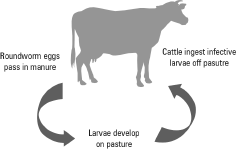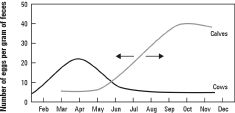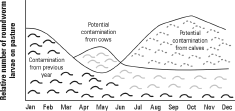| | Worm species in cattle | Life cycle of roundworms | When do cattle become infected? | How do roundworms harm cattle? | How will I recognize the problem? | Do my cattle have worms? | Prevent cattle from getting roundworms
Parasitic roundworms, or nematodes, are found year-round in cattle in Alberta. These parasites live in many sites including:
- lungs
- body cavity
- tear or lacrimal ducts
- beneath the skin
- gastro-intestinal tract
Each area is occupied by roundworms specific to those sites. Cattle producers should be aware of the more important worms that can live in their cattle.
Worm Species in Cattle
Cattle host over 14 different species of gastro-intestinal roundworms. Different species live in different locations in the intestine. As there are usually just a few of these roundworms present, the harm they cause is not always apparent and can be difficult to assess.
Four species live in the abomasum:
- barber pole worm (Haemonchus placei)
- brown stomach worms (Ostertagia ostertagi and O. bisonis)
- threadworm (Trichostrongylus axei)
Six species live in the small intestine:
- thread-necked worm (Nematodirus helvetianus)
- four species of cattle bankrupt worms (Cooperia spp.)
- cattle hookworm (Bunostomum phlebotomum)
Four species live in the large intestine:
- nodular worm (Oesophagostomum radiatum)
- whipworm (Trichuris discolor)
- large-mouthed bowl worm (Chabertia ovina)
- hairworm (Capillaria bovis)
Some of roundworms listed above are rare or occur only in specific geographic areas. Other roundworms are common throughout the province wherever cattle are raised.
This factsheet will focus on the more common intestinal roundworms found in Alberta.
Life Cycle of Roundworms
Although some details vary, the life cycle of all the gastro-intestinal roundworms of cattle follows a similar pattern (Figure 1):
| 1. | Female roundworms lay microscopic eggs that pass in the manure of cattle. |
| 2. | Within a few days, a free-living larva develops and hatches from the egg. |
| 3. | The hatched larva develops through a second, and then a third stage where it becomes capable of infecting cattle. Larval development on pasture takes only a few days in warmer months, but takes several weeks during cooler weather. |
| 4. | Cattle become infected with roundworms as they graze on pasture or by ingesting food or water contaminated with manure containing infective larvae. |
| 5. | The larvae mature in the intestine and then mate. The females begin shedding eggs within two to four weeks after being ingested by the cow. |

Figure 1. Life cycle of gastro-intestinal roundworms
When do Cattle Become Infected?
Roundworms live for approximately one year in cattle. As the previous year's adults die, they are replaced by a new generation of parasites. This stage generally occurs from June to August. This annual cycle has two high points for egg output: one in the spring and one in the late summer/early autumn (Figure 2).

Figure 2. Number of roundworm eggs shed in the feces of animals on pasture
The spring high point is caused by several factors:
- adult nematodes that survived in cows from the previous year increasing egg output
- larvae ingested the previous fall resuming their development, maturing and beginning to produce eggs
- cows ingesting larvae that over-wintered on pasture - while many larvae do not survive winter on pasture, some, like the thread-necked worm, may over-winter for one or two years
The late summer/early autumn high point in egg output is caused by the eggs deposited by calves grazing summer pasture.
The number of eggs shed in cow feces decreases in June or July, as the adult roundworms acquired by cattle the previous summer are lost. This decrease in egg output continues as autumn progresses.
The winter decrease results from the following:
- loss of some adult worms from the hosts' intestine
- slowing of egg production by the remaining worms
- larvae ingested in late autumn not maturing until spring
The seasonal variation in number of infective larvae on pasture is similar to the pattern of egg shedding. After the winter decrease comes a small spring/early summer peak comprised of larvae that survived over winter as well as larvae derived from the increase in fecal egg shedding in cows (Figure 3).

Figure 3. Seasonal change in the number of roundworm larvae contaminating pastures
The timing and size of these peaks and falls vary depending on environmental conditions. In some years, the spring peak may not occur at all.
How Do Roundworms Harm Cattle?
Roundworms can harm cattle in two ways:
- They can puncture the small blood vessels of the abomasum and feed on blood. Large numbers of blood feeders can cause anemia, poor growth and, occasionally, death.
- Some roundworms, particularly the brown stomach worm, can penetrate into the glands lining the wall of the abomasum. These glands produce digestive juices necessary to break down food before it can be absorbed by the intestine. The damage may cause diarrhea, malnutrition and poor growth.
How Will I Recognize the Problem?
A few worms will cause little damage and leave no obvious signs of their presence. Well-nourished cattle may not show signs of infection, but may not gain as much weight as should be expected. More heavily parasitized animals may lose appetite, fail to gain weight as expected, and they appear thin and in poor condition when compared with others of similar age.
Some cattle also develop persistent scours, while others have mild, intermittent or no scouring.
Do My Cattle Have Worms?
Collect a sample of manure and examine it for parasite eggs. A veterinarian can count the eggs to get an indication of the number of parasites present and the potential for pasture contamination.
However, as the eggs of many species (except those of the thread-necked worm) are similar in appearance, specific worms cannot be identified until the larvae develop and hatch. Identification can then be made based on characteristic features of the larvae.
Prevent Cattle From Getting Roundworms
Anthelmintic treatment given to cattle before turnout will reduce the shedding of nematode eggs in the feces and will reduce pasture contamination. As some anthelmintics provide residual protection for several days or weeks, new parasites taken in by cattle during this time will also be killed. A second treatment given late July or early August will further reduce pasture contamination and prevent roundworms from establishing in cattle.
Several broad-spectrum anthelmintics are currently available for controlling worms in cattle. The decision to treat or not to treat is best made by consulting your veterinarian, who can then recommend an appropriate drug and treatment program.
Prepared by:
Murray Kennedy, Ph.D.
Food Safety Division
Source: Agdex 655-9. December 2004. |
|